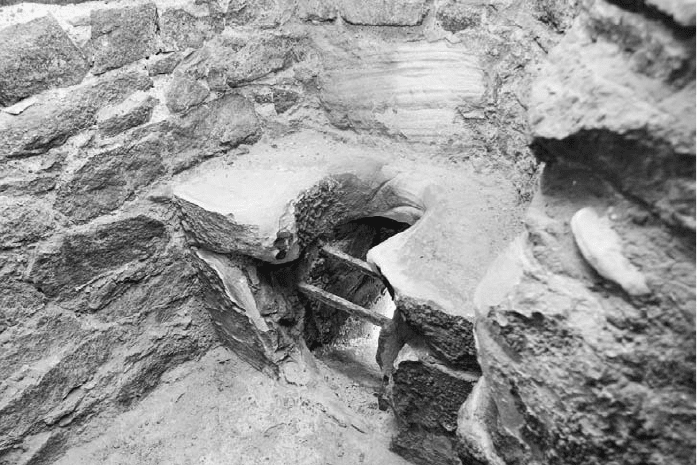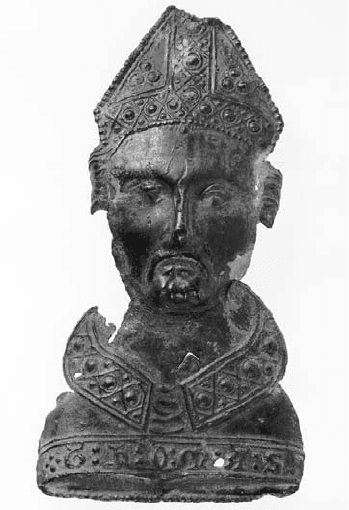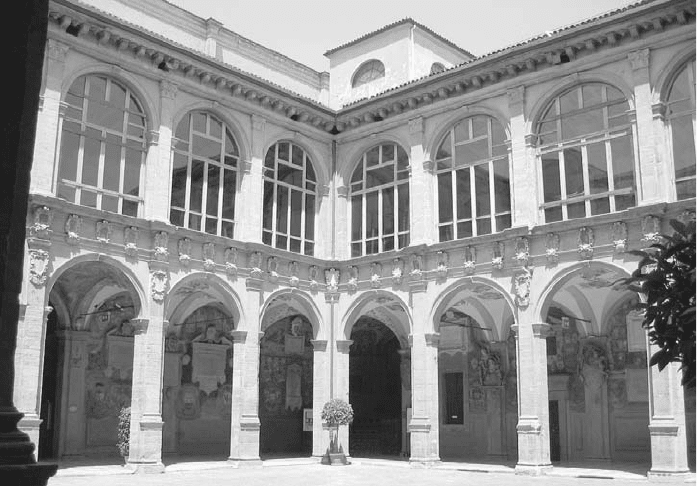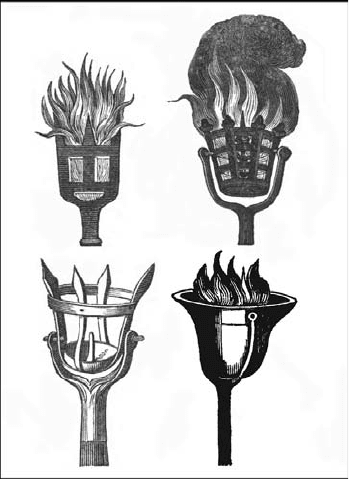Johnston R.A. All Things Medieval: An Encyclopedia of the Medieval World
Подождите немного. Документ загружается.


Latrines and Garbage
440
chute at night to get into the castle. Waste could also fall into the moat,
adding to the moat’s unattractiveness. If so, then the castle’s residents peri-
odically moved to another house while the moat was dredged.
The bigger, richer monasteries developed systems of simple plumbing.
They channeled rain or spring water through pipes into the buildings
and then used the wastewater to fl ush the latrines out. A typical “rere-
dorter,” the wing of a monastery devoted to latrines, was planned so many
monks could use the facility within a short time, since they lived on a sched-
ule. There was a row of wooden seats, separated by wooden walls for pri-
vacy, each with a shuttered window that could be opened for light and
air. Some monasteries could have used rags from old robes as toilet tissue,
while most others used hay.
Monasteries often had a source of running water, either piped in or by
means of a creek or diverted river channel. Monasteries with water sys-
tems used the waste from all other washing and cooking to fl ush out the
latrines, and a fi nal waste ditch carried all the wastewater off the property.
Sometimes, the wastewater went into the fi shpond, where algae fed on the
excrement; this was the fi rst simple sewage treatment system. More com-
monly, the sewage fl owed into the nearest river. Occasionally, it fed onto
someone’s property.
This castle garderobe has survived better than many since not only the closet and
chute but also the seat were made of stone. Daylight shines up through the hole,
which leads straight to the sea. (iStockphoto)
Latrines and Garbage
441
Town buildings with space to include a cesspit in the backyard did so. By
the late Middle Ages, city ordinances usually required that cesspits be lined
with stone to try to keep them from leaking into the surrounding soil and
contaminating wells. Some cesspits used barrels to line the shaft. About
every two years, they had to be dug out and the muck carted away. Digging
out cesspits was a regular trade for some laborers. The manure from each
pit was hauled out of the city in carts. It was a valuable resource for agri-
culture and was often sold as fertilizer after minimal processing.
A cesspit usually had a privy built over it. Frequently these were shared
among several families and could have more than one seat. When a large
city house had room for a cesspit, the owners sometimes placed a latrine at
the back of an upper room (a solar), with a pipe carrying the waste to the
pit outside. This was the closest thing to indoor plumbing. Anyone who
did not want to climb down the stairs or ladder to go outside to the privy
(or who did not have a privy) used a chamber pot and needed to empty it
into a cesspit.
Some cities had public latrines to keep the streets from being fi lled with
fi lth. London, in the 14th century, had a row of public toilets along the
river where the tide in the Thames Estuary would fl ush the cesspits out
twice a day. The privies were divided into men’s and women’s. River la-
trines gradually turned the city’s streams into open sewers.
In 1357, King Edward III set out to inspect the Thames and Fleet rivers.
These rivers stank badly even by medieval standards. Only 10 years earlier,
the Black Death plague had swept through London, and nobody knew
what had caused it, but “bad air” was considered a great risk factor for a
repeat of the plague. He closed some latrines along the Fleet and Thames
rivers and forbade the building of new ones. The rivers were dredged, and
owners of the latrines that remained had to contribute to the cost.
Garbage
Cities had the most diffi culty with sanitation. In cities, people, animals,
and businesses were packed into a small space, with no room for each fam-
ily or business to develop its own outhouse or latrine pit. Waste often went
into the streets. This included not only human waste and animal waste,
but also butchering waste (blood, entrails, and skin). Dogs, pigs, and rats
roamed the streets eating what they could. Large city streets, especially
in the 14th and 15th centuries, were sometimes paved and had gutters
and drains. A wide street with two gutters could count on rain washing
the streets at times. Cities like London also employed rakers to sweep the
streets and carts and boats to carry the refuse away. Cities also tried to ex-
terminate rats, although they were not aware of the rat’s role in spreading
disease.
Latrines and Garbage
442
Medieval people maintained a certain amount of recycling for pragmatic
and economic reasons. Some food waste could be turned into materials for
industry, like the bones and skin from butchering that went to make glue,
leather, and parchment. Butchers may have dumped blood and entrails,
but much of what could have been dumped was sold to pie makers or given
to charity, since the poor were always happy to eat any animal products.
Worn-out clothing could always be made into something else, and even-
tually it became either high-quality toilet tissue or rags sold to the paper
industry. Parchment and paper were rarely thrown away; they were re-
purposed by having something else written on the reverse or by being
scraped or erased for a second use. Broken glass was called cullet; it was
collected to be melted again by glassmakers. Candle ends, which could
be melted down, were treasured to the point that they were part of some
servants’ wages and benefi ts.
Still, garbage disposal, particularly of industrial waste such as the scrap-
ings and used chemicals from tanning, was a huge problem in cities. In
Paris, there were civil trials in which neighbors sued butchers, arguably the
messiest of the trades, for fouling the streets and stinking up the air. Butch-
ers were supposed to haul their waste outside the city, but many put it into
the street instead. The city fi nally forced many butchers to move outside
the walls and locate along the Bièvre River, where tanners and dyers were
also locating. The river soon became nearly clogged with sewage, which
then fl owed into the Seine and eventually out to the sea.
Italian towns passed stringent regulations for keeping the streets clean.
Dumping water from upper windows was against the law; backyard privies
had to be walled up and lined with stone so as to keep from leaking. Streets
had to be kept clean; even grape skins were to be swept up. Neighbors were
responsible for periodically washing the streets with river water. Dead ani-
mals had to be hauled outside the city, as did all other bone waste. All vio-
lators who were caught were immediately fi ned.
Toward the end of the Middle Ages, some cities had built drains and
sewers into their main streets. Citizens who lived along these roads some-
times piped their waste into the city’s main drain system. The hygiene-
conscious Italian cities encouraged and at times required this, since it kept
the alleys from becoming smelly marshes.
Ultimately, the waste all emptied into the nearest running water. Cit-
ies situated on rivers were easier to fl ush, but the resulting river pollution
could be extreme. Smaller channels could become hard to navigate due to
the volumes of fl oating waste, and even large rivers smelled bad. The water
was no longer safe to use, which was a problem since many people had tra-
ditionally used river water. The fi sh were polluted as well and could not
safely be eaten. Improperly treated waste could also contaminate wells, es-
Lead and Copper
443
pecially within a city. Cities tried to keep public water supplies clean, but it
was not possible to keep anything entirely clean.
See also: Cities, Monasteries, Water.
Further Reading
Dean, Trevor. The Towns of Italy in the Later Middle Ages. Manchester, UK: Man-
chester University Press, 2000.
Gies, Joseph, and Frances Gies. Life in a Medieval Castle. New York: Harper and
Row, 1974.
Gies, Joseph, and Frances Gies. Life in a Medieval City. New York: Harper and
Row, 1969.
Hanawalt, Barbara A. Growing Up in Medieval London: The Experience of Child-
hood in History. New York: Oxford University Press, 1993.
Magnusson, Roberta J. Water Technology in the Middle Ages. Baltimore: Johns
Hopkins University Press, 2001.
Wright, Lawrence. Clean and Decent: The Fascinating History of the Bathroom and
the WC. Toronto: University of Toronto Press, 1967.
Lead and Copper
Medieval Europe used gold and silver for coins, iron for weapons and
some tools, and only a few other metals for all other purposes. Copper was
mined on Cyprus, in Germany, and in a few other places. Trace elements
of metals like arsenic and antimony were found in the impure copper ore,
and, for cheaper products, they were often left in to add bulk; the best cop-
per, used for casting fi ne bronze and brass, had to be refi ned. Tin and lead
were often found with silver and had long been mined in England, France,
and Germany. Metal was also recycled. The Romans had used lead for many
purposes, and the pipes, gutters, and tools they left around Europe were
melted and recast.
Copper alloys commonly were used to make many household objects,
especially for the kitchen. Bronze was an alloy of copper and tin, with very
little zinc. Brass, on the other hand, was made of copper and zinc, with
little to no tin. Gunmetal, also called latten, used copper, tin, and zinc to-
gether. Lead could be mixed into any of these, especially latten. Since me-
dieval craftsmen had no sense that lead was poisonous, they did not hesitate
to use lead in metal alloys for pitchers and other table utensils. Latten was
the cheapest metal and could be used for many small cast objects, especially
candlesticks. Pewter was an alloy of tin developed in the later Middle Ages.
A poorer sort of pewter, used for pots and candlesticks, was made with lead
and tin. Fine pewter was made of copper and tin, and it was considered

Lead and Copper
444
nearly as good as silver. It had a higher proportion of tin, as compared to
bronze, which was higher in copper.
Bronze items were cast using the lost-wax method. The desired shape was
carved in wax, which was then packed into clay. When molten bronze was
poured into the clay, the wax melted and poured out drainage holes. The
bronze fi lled the spaces and, when cooled, took on the original shape of the
wax. Bronze casters were sometimes called potters in English; casting mol-
ten metal is also called foundering, and the place that does it is a foundry.
Bronze casters made many kinds of kitchen pots, and they also made
chamber pots. Households used as many bronze pots as iron ones, although
later times used only iron skillets and cauldrons. Bronze casters also made
church bells, which was an art in itself. Those who specialized in the craft
were bell founders. The bronze for bells was approximately four-fi fths cop-
per and one-fi fth tin.
Bronze and brass were used to make funeral effi gies and memorials.
Only royalty could afford three-dimensional cast bronze effi gies. For one
set of effi gies of King Henry III and his daughter-in-law, Queen Eleanor
of Castile, a goldsmith carved the wax originals. A bronze founder used
these wax fi gures to mold and cast in bronze. Brass was a new material in
the Middle Ages. It was cast in sheets and made into fl at, etched funeral
memorials.
Thousands of pilgrims came to holy
places like Canterbury, the site of the
martyrdom of Saint Thomas. They
wanted to carry away a holy souvenir,
but many of them were humble people
who could not afford much. Lead
badges were the cheap solution. A lead
badge could be affi xed to the pilgrim’s
hat or pack, and it would not easily
break or rust. Lead pilgrim badges in
many shapes were turned out by the
thousands all over Europe. (Museum of
London/StockphotoPro)
Libraries
445
Lead was a very useful metal because it was soft and because its melt-
ing point was so low. It did not require specialized furnaces, but it kept its
shape in air temperatures. Plumbers melted new and old lead into sheets
and then cut it into roof tiles; lead roof tiles were the most popular kind.
Lead was also used to hold together panes of glass, both clear and stained.
Lead was easy to cast and bend, and it could be soldered in place with a
mixture of tin and lead, using salt or tallow as the fl ux.
Lead pipes formed the water systems of many monasteries and cities.
Rome had used lead for pipes, and no physicians had yet noticed lead poi-
soning, perhaps because it was widespread. First, the metal was melted and
cast in sheets. Long strips of sheet lead were bent around a wooden pole,
and then the pole was removed. The pipe needed a fi rm seam to make it
watertight. Lead was easy to melt, but it always needed a mold, even for a
seam. The new pipe was fi lled with sand and wrapped in clay, leaving only
the crack where the seam needed to be. Now the craftsman could pour
very hot lead into the crack, where it melted the edges of the pipe and then
cooled, forming a welded seam.
Both pewter and pure lead were molded to make decorative shapes and
pins, such as badges pilgrims pinned to their hats. Although lead was not a
precious metal, lead pilgrims’ badges could be mounted with small, inex-
pensive jewels. Lead could also form a white crusty oxide when exposed
to ammonia, and this white lead was the main source of white pigment in
paint. Roasted, it turned yellow and orange.
See also: Bells, Iron, Kitchen Utensils, Painting, Water.
Further Reading
Badham, Sally. Monumental Brasses. Botley, UK: Shire Publications, 2009.
Buckley, Allen. The Story of Mining in Cornwall. Fowey, UK: Cornwall Editions,
2007.
Egan, Geoff. The Medieval Household: Daily Living c. 1150–c. 1450. Woodbridge,
UK: Boydell Press, 2010.
Harvey, John. Mediaeval Craftsmen. New York: Drake Publishers, 1975.
Magnusson, Roberta J. Water Technology in the Middle Ages. Baltimore: Johns
Hopkins University Press, 2001.
Spencer, Brian. Pilgrim Souvenirs and Secular Badges. Woodbridge, UK: Boydell
Press, 2010.
Libraries
In ancient times, there had been libraries of clay tablets and scrolls, and the
Romans had both public and private libraries in many cities. Some public
libraries in Rome were like modern reading rooms, and some were placed
Libraries
446
in the building that held the public baths. Each book, in the form of a
parchment roll, had a little tag on the end of it bearing the author’s name.
Rolls were stacked on shelves or set upright into buckets. Some of these
ancient Latin scrolls were still housed in the oldest medieval libraries, such
as in Rome itself. Another form of book, the codex, was developed in the
fi rst century
A.D . A codex was a stack of thin boards that were covered with
parchment; little holes were drilled in the edge so the boards could be
bound together with cord.
Christian writers in the early Middle Ages preferred the codex over the
scroll for their copies of the gospels. In many cities, bishops amassed private
libraries, usually consisting of either books of the Bible or commentaries
on the Bible and religious issues. However, some bishops also had secular
works in their libraries. In the seventh century, the famous scholar Isidore,
bishop of Seville, owned a notable library. He had not only religious and
biblical books but also copies of books by famous Latin writers of earlier
centuries, along with medical books and legal writings.
In the early 800s, Charlemagne made great efforts to broaden Frankish
book production. He set monks and scholars to copying books, and
he organized schools to encourage literacy; he and his sons attended,
to set the example. Under Charlemagne’s encouragement, monasteries ’
book holdings expanded. Libraries that contained only 30 or 40 books
before Charlemagne’s reign had as many as 300 books by the middle
of the ninth century. The largest monastic libraries had more than 600
books, an astounding achievement in the relatively primitive Frankish
kingdom.
The greatest libraries of medieval Europe were located in Cordoba, the
capital of Muslim Spain. Arab scholars were enthusiastic translators and
writers, and the city kept hundreds of copyists employed. The caliph’s li-
brary was reputed to have 400,000 volumes, and it was one of perhaps as
many as 70 other city libraries. Other Andalusian cities like Barcelona had
great libraries and became centers of learning that drew scholars from the
Christian countries. The Muslim passion for translation preserved, at least
in Arabic, many Greek classics that were otherwise lost. Aristotle’s reentry
into the scholasticism of Christian Europe began with the Arabic transla-
tions of his works, which then were translated into Latin for use in Euro-
pean universities.
As the monastic movement spread across Europe, monasteries devel-
oped libraries in conjunction with their scriptoria, especially in Italy, Ger-
many, Switzerland, and England. The scriptorium was a well-lighted room
where monks worked as scribes, making new copies of books and, like the
rest of the monks, working six days a week. Sunday was not a workday, and
in many monasteries the monks were to get a book from the monastery
library and spend the day reading the Bible or other Christian literature.

Libraries
447
Most monastery libraries had only a few hundred books, but they were
required to have at least one book per monk. Books from the library also
were used in the schools that many monasteries started, where the monks
taught the village boys to read.
A few monastery libraries loaned books to the public, but with a strong
emphasis on making sure the books were brought back. In some cases, the
borrower had to leave something of value with the librarian as a deposit to
assure return of the borrowed book. Some libraries coped with the problem
by chaining the most valuable books to desks. The problem of borrowers’
failure to return books, whether in public, private, or monastery librar-
ies, brought about the creation of many forms of the “book curse.” These
curses threatened the careless reader with dire consequences if he failed to
return the book, including eternal damnation, disease, agony, and the judg-
ment of God himself.
By the end of the 14th century, there were more than 75 universities
in Europe. Each one had its own library, often with a “great library”—a
reading room where people could study. The university’s “small library”
was a storeroom for books loaned to members of the university. Univer-
sity libraries developed specifi c book collections for the study of theology,
both church and civil law, medicine, and sciences such as geography and
Bologna’s university was the fi rst established in medieval Europe. Its library has one
of the greatest antiquarian book collections in the world. (Kelly Borsheim)
Lights
448
astronomy; these books were loaned to students. Residential colleges
within the universities, acting as dormitories, also collected libraries for
their students. Other sources of books for students were stationers’ shops—
the publishers of the day—where books were copied and bound and loaned
to students for a fee.
See also: Books, Monasteries, Parchment and Paper, Printing, Univer-
sities.
Further Reading
Butt, John J. Daily Life in the Age of Charlemagne. Westport CT: Greenwood
Press, 2002.
Casson, Lionel. Libraries in the Ancient World. New Haven, CT: Yale University,
2001.
Murray, Stuart A. P. The Library: An Illustrated History. New York: Skyhorse Pub-
lishing, 2009.
Lights
The primary source of light in the Middle Ages was the sun; nearly all work
was done during daylight hours. Workers began with the sun and stopped
work at sunset. Many guilds specifi ed that craftsmen could not work at
night, since the available light sources were so poor. It would be too easy
to miss fl aws in the work. Certain kinds of work required many windows,
and workrooms had as many windows as could be managed without los-
ing suffi cient heat. Many crafts worked in the open air.
The secondary source of light, indoors, was the fi re. Most houses had
open fi re pits or hearths in the center of the room. Since windows provided
light but also allowed heat to escape, houses in the northern regions had
few windows, and they were typically shuttered in the winter. House interi-
ors were dark, and the fi re provided the light for most inside activity. It was
enough for spinning, basic sewing, animal care, and basic cooking. When
fi replaces were invented for castles and began to be incorporated into some
newer city houses, fi res could be brighter without fi lling the room with
smoke, and they probably provided more light.
Fires could be started with a spark from fi re irons. The friction of the
irons being rubbed together cast sparks onto kindling materials. Light-
weight, dry materials like straw, tow, dried toadstools, and dried weeds
caught the spark. Dry twigs and good kindling wood made the fi re grow,
and fi nally solid wood could be piled onto it. Oak, ash, and beech were
the best woods for household fi res. Starting a fi re was such a production
that most households tried to keep their fi re from completely dying out.

Lights
449
Banking large coals of burning wood with ashes slowed the combustion
and meant that in the early morning, the servant or housewife who raked
through the ashes could fi nd coals that soon glowed red again. If the coals
did not light, neighbors were often willing to send a few good coals over
in a fi re pan. Another simple tool, the pottery couvre-feu, or curfew, was a
ventilated lid that could help bank the fi re for the night. With good kin-
dling, the fi re was soon hot again. Fires could be made hotter with a bel-
lows. Men also blew on fi res to make them hotter.
Fire could be a portable light when carried in an iron or pottery bas-
ket called a cresset. Lighthouse beacons were controlled fi res in cressets.
Watchmen in cities kept cressets with burning wood all night; they could
carry them to the scene of a disturbance.
The liturgical year included several festivals when candles and other
lights were featured. A medieval Latin hymn for Easter describes the
lighting of a new fi re with fi re irons and the variety of lights brought from
home to be kindled at the new fi re. Pottery oil lamps with wicks fl icker-
ing into light, pine torches spitting sparks into the air, and beeswax can-
dles, still smelling of honey and dripping wax onto the fl oor, are described
vividly.
Torches were the most ancient kind of light and were used less as the
Middle Ages passed. Their natural pitch content made the wood burn well
for a long time. They were used in outdoor processions at night and in
Cressets were small baskets to carry
coals and fi re. The cressets pictured
here could be carried like torches. They
were the only kind of light that could
be picked up easily and carried out-
doors to the scene of an emergency, so
night watchmen always had cressets and
a central fi re source. (Francis Douce,
Illustrations of Shakespeare, and of
Ancient Manners, 1807)
